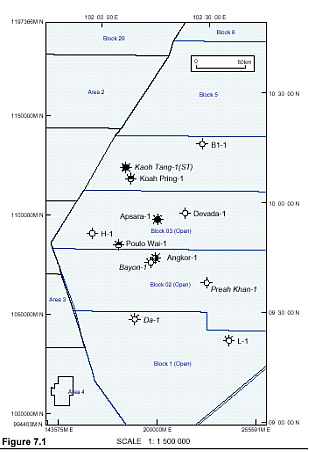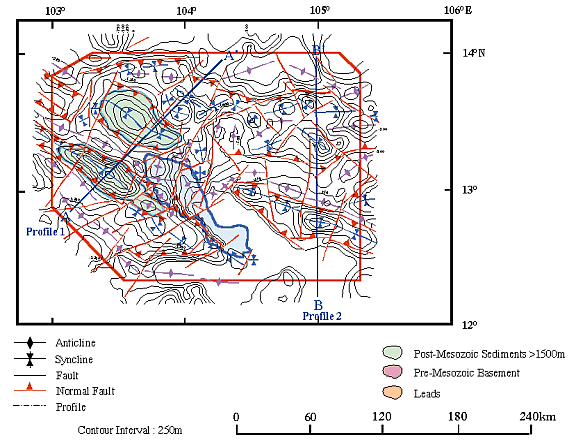|
|
| |
The
regional seismic survey will be conducted soon along the
National Road #5 from Kampong Chhnang Province to Battambang
Province. |
| |
|
| |
Offshore
Exploration |
| |
|
| |
Following
the introduction of new Petroleum Regulations in
1991, an initial Cambodian bidding round was announced,
calling for bids on offshore and onshore blocks.
Although foreign interest in the onshore blocks
was muted, production sharing contracts (PSCs) were
awarded to Enterprise (Blocks 1 and 2), Campex (Block
3), and a pairing of Premier Oil and Idemistu (Block
4) in the offshore area.
As
a result, a total of nine wells were drilled and
about 13,675 km of 2D seismic lines and 1 050 km2
3D seismic surveys were acquired and processed in
these offshore blocks by those companies during
1990-1997. While none of these exploration wells
were considered commercially viable at that time,
amounts of gas, condensate, and waxy crude oil with
low sulphur contents have been found in three of
them: Angkor, Koah Tang and Apsara. Other wells,
Da-1, Bayon-1, Poulo Wai-1, and Koah Pring-1 have
been found to have traces of oil and gas.
|
 |
|
| |
|
| |
By
the end of 1998, limited exploration success and collapse
of world oil prices prompted all foreign companies holding
the PSCs to withdraw from Cambodia. In the same year,
though, an Australian company - Woodside Petroleum was
awarded PSCs for Offshore Blocks 5 and 6. Woodside acquired
5 000 km of 2-D seismic lines under the initial two-year
exploration period provided by the PSCs. Despite identifying
several prospective structures - mainly in Block 5 - the
consortium relinquished Block 5 in 1999 and Block 6 in
2000. |
| |
|
| |
In
1999, Woodside entered into a the Study Agreement with
CNPA covering blocks I-IV and VII with the purpose to
determine the prospectivity of those blocks and feasibility
of developing the discovered reserves. The result of the
Study has shown that there is some potential for gas to
be present in the area and a model has been developed
to assess the reserve potential of the area based on analogue
from elsewhere in the Gulf of Thailand. Gas as a stand-
alone or in conjunction with condensate is assessed the
most viable development scenario. |
| |
|
| |
|
| |
|
| |
Onshore
Exploration |
| |
|
| |
An
airborne magnetic and gravity survey conducted by the
Japan National Oil Corporation in 1996 identified two
deepest sedimentary features in the Tonle Sap Basin. The
areas to the north and west of the Tonle Sap Lake is thought
most likely to hold hydrocarbons. This is the basin surrounding
the Tonle Sap Lake, Cambodia's largest lake and one of
the world's largest fresh water fishing grounds. In the
conclusion of the JNOC report, surface geological mapping,
higher density rock sampling and 2D- seismic regional
line across the grabens were recommended to be carried
out in the area. |
| |
|
| |
In
addition, Cambodia has also signed a two-year contract
with Mitsui Oil Exploration Co., Ltd to undertake remote
sensing study to evaluate the hydrocarbon potentials of
the entire Tonle Sap area. |
| |
|
| |
At
the same time, Sinopec from China has conducted a field
trip around the Tonle Sap Area to collect rock samples
for geochemical analysis. |
| |
|
| |

|
| |
|
| |
|
| |
|
|

